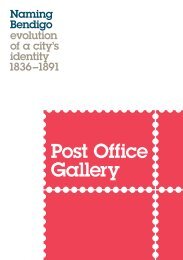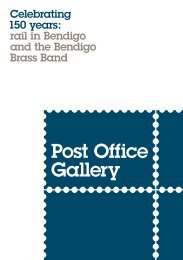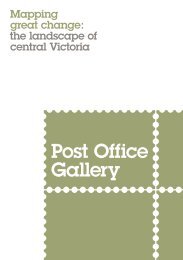A cure for all ills: medicine in Bendigo
This electronic publication accompanies the exhibition A cure for all ills: medicine in Bendigo. From chaotic beginnings to the formation of professional practice, the introduction of regulations against quackery and the establishment of long standing institutions such as Bendigo Hospital, A cure for all ills: medicine in Bendigo explored the social history surrounding the foundations of healthcare in Bendigo and the contribution of doctors, pharmacists, dentists, nurses and Chinese herbalists in providing essential health services to the community.
This electronic publication accompanies the exhibition A cure for all ills: medicine in Bendigo.
From chaotic beginnings to the formation of professional practice, the introduction of regulations against quackery and the establishment of long standing institutions such as Bendigo Hospital, A cure for all ills: medicine in Bendigo explored the social history surrounding the foundations of healthcare in Bendigo and the contribution of doctors, pharmacists, dentists, nurses and Chinese herbalists in providing essential health services to the community.
Create successful ePaper yourself
Turn your PDF publications into a flip-book with our unique Google optimized e-Paper software.
‘A tra<strong>in</strong><strong>in</strong>g school <strong>for</strong><br />
nurses commenced<br />
at <strong>Bendigo</strong> Hospital<br />
<strong>in</strong> 1885, mark<strong>in</strong>g the<br />
beg<strong>in</strong>n<strong>in</strong>g of nurs<strong>in</strong>g<br />
education <strong>in</strong> the<br />
region.’<br />
School 64 <strong>in</strong> class with<br />
Sister Miller<br />
c1965<br />
gelat<strong>in</strong> silver pr<strong>in</strong>t<br />
Northern District School<br />
of Nurs<strong>in</strong>g Assembly<br />
Room set-up <strong>for</strong> f<strong>in</strong>al<br />
exams<br />
1957<br />
gelat<strong>in</strong> silver pr<strong>in</strong>t<br />
Collection Northern<br />
District School of<br />
Nurs<strong>in</strong>g Graduates<br />
Association<br />
<strong>for</strong> by male wardsmen with female<br />
nurses only employed with the<br />
admittance of female patients. The<br />
first recorded female nurse employed<br />
by the <strong>Bendigo</strong> hospital was Janet<br />
Morgan <strong>in</strong> 1859. 34 Early nurses were<br />
untra<strong>in</strong>ed, and <strong>in</strong> addition to patient<br />
care their role entailed a significant<br />
amount of menial housekeep<strong>in</strong>g<br />
chores.<br />
In 1859, after serv<strong>in</strong>g as a nurse<br />
<strong>in</strong> the Crimean War, Florence<br />
Night<strong>in</strong>gale published her famous<br />
Notes on Nurs<strong>in</strong>g. By 1860, she had<br />
become hospital advisor to the world<br />
and is credited as the founder of<br />
modern nurs<strong>in</strong>g, with a focus on<br />
discipl<strong>in</strong>e, cleanl<strong>in</strong>ess and service.<br />
Nurses’ tra<strong>in</strong><strong>in</strong>g <strong>in</strong> Australia was built<br />
on the foundations of the Night<strong>in</strong>gale<br />
system; an apprentice-type scheme<br />
where <strong>for</strong>mal tra<strong>in</strong><strong>in</strong>g was completed<br />
<strong>in</strong> the wards of selected tra<strong>in</strong><strong>in</strong>g<br />
hospitals and student nurses received<br />
theoretical <strong>in</strong>struction <strong>in</strong> the <strong>for</strong>m of<br />
cl<strong>in</strong>ical and classroom lectures often<br />
presented by the Matron, resident<br />
surgeon or general practitioners<br />
outside rostered hours.<br />
A tra<strong>in</strong><strong>in</strong>g school <strong>for</strong> nurses<br />
commenced at <strong>Bendigo</strong> Hospital<br />
<strong>in</strong> 1885, mark<strong>in</strong>g the beg<strong>in</strong>n<strong>in</strong>g<br />
of nurs<strong>in</strong>g education <strong>in</strong> the<br />
region. The facility was under the<br />
direction of resident surgeon Dr<br />
Archibald Colquhoun. Aside from<br />
a short recess <strong>in</strong> the late 1880s, the<br />
school cont<strong>in</strong>ued until 1989. The<br />
<strong>in</strong>troduction of <strong>for</strong>mal tra<strong>in</strong><strong>in</strong>g<br />
elevated the status of nurses <strong>in</strong> the<br />
<strong>Bendigo</strong> hospital. By the 1890s,<br />
genu<strong>in</strong>e attempts were be<strong>in</strong>g made<br />
to differentiate between nurs<strong>in</strong>g<br />
staff and housekeep<strong>in</strong>g staff and the<br />
hierarchy of the hospital became<br />
clearly def<strong>in</strong>ed by those who were<br />
tra<strong>in</strong>ed and those who were not.<br />
By the turn of the century,<br />
while nurs<strong>in</strong>g had matured <strong>in</strong>to a<br />
specialised profession and work<strong>in</strong>g<br />
conditions had somewhat improved,<br />
nurses were still poorly renumerated.<br />
Local nurse Isabel ‘Spark’ Gill, who<br />
commenced nurs<strong>in</strong>g at <strong>Bendigo</strong><br />
hospital <strong>in</strong> 1936, received her<br />
tra<strong>in</strong><strong>in</strong>g under the Night<strong>in</strong>gale<br />
system. In her book Nurs<strong>in</strong>g <strong>in</strong> the<br />
30s, she describes the conditions<br />
of nurs<strong>in</strong>g at the time. ‘Nurses<br />
worked sixty hours a week or longer<br />
without overtime and <strong>for</strong> no or<br />
little remuneration. Most hospitals<br />
expected nurses to provide their own<br />
uni<strong>for</strong>ms. Nurses lived <strong>in</strong> nurse’s<br />
homes under strict supervision, and<br />
attended lectures <strong>in</strong> their own time.<br />
22 23

















